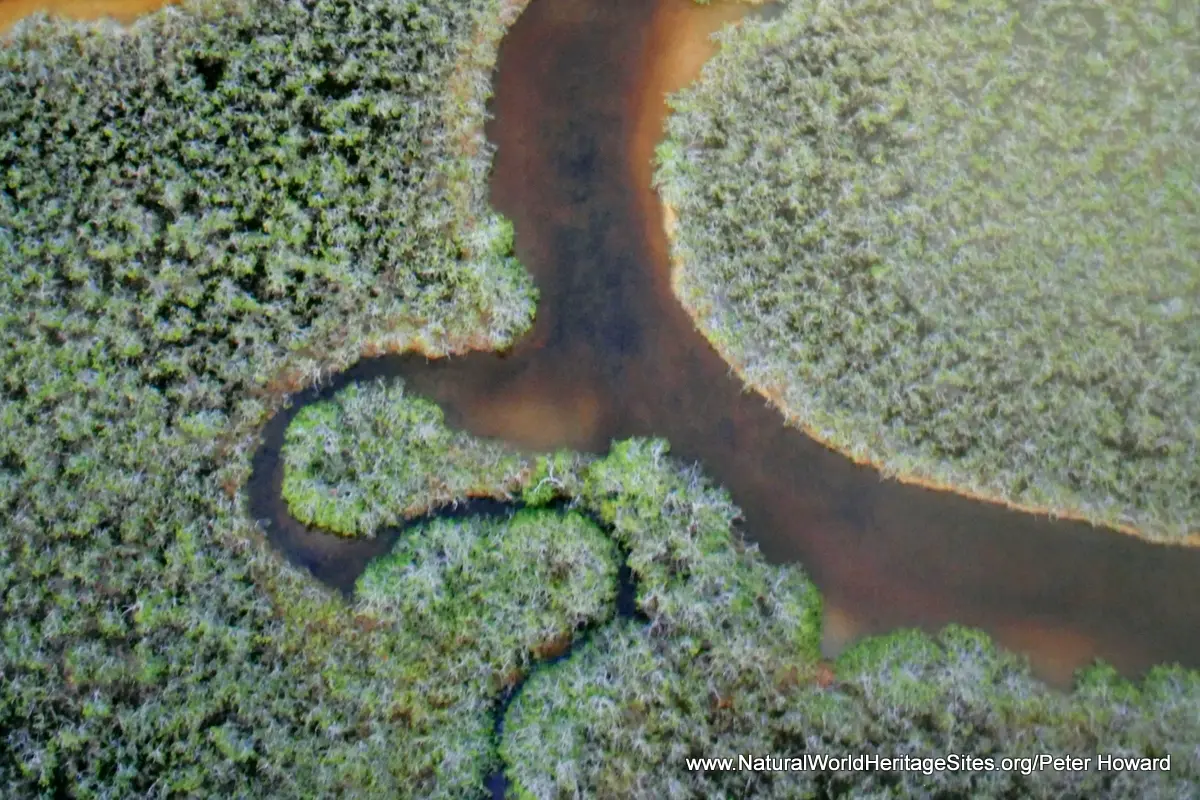EXPLORE Sian Ka’an with this slideshow, check the location map and get all the facts and information below.
For slideshow description see right or scroll down (mobile). Click to view slideshow
Location and Values: Sian Ka’an lies on the eastern shores of Mexico’s Yucatan peninsula, about 100 km south of the resort town of Cancun. It covers a complex mosaic of wetlands, marshes, mangroves, and tropical forests, along a diverse coastline with offshore coral reefs and seagrass beds. The area features some unusual natural phenomena, including hundreds of forested islands (so-called ‘Petenes’) emerging from the grassy marshlands, and deep natural sinkholes (known as ‘cenotes’) in the underlying limestone rock, filled with crystal-clear freshwater and hosting specialized communities of life (including many endemic species). The marine portion of the site covers part of the MesoAmerican Barrier Reef and supports at least 80 species of corals and more than 400 species of fish as well as four species of turtle and a small population of West Indian manatees. Meanwhile the terrestrial habitats support at least 100 species of mammals and 330 species of birds, including rare and endangered species such as jaguar, puma, tapir, black-handed spider monkey and Yucatan black howler monkey.
Conservation Status and Prospects. According to IUCN’s Conservation Outlook Assessment (2017) the conservation status of Sian Ka’an is ‘good, with some concerns’. The IUCN report notes that ‘out of the large number of current threats coastal development, mostly related to tourism, stands out as a major concern with multiple direct and indirect impacts on land and in the sea, including pressure on species, disturbance,
depletion of freshwater and sewage and waste. There are clear indications that the marine and coastal environments may be severely affected by climate change with its expected sea level rise and the effects of anticipated temperature increases and related ocean acidification on reefs and other marine ecosystems. ’
Links:
Google Earth
UNESCO Official Website
IUCN Conservation Outlook
UNEP-WCMC Site Description
Slideshow description
The slideshow ‘tells the story’ of Sian Ka’an, showing its landscapes, habitats, plants and animals, and illustrating some of the threats and conservation needs. The photos were taken by Peter Howard during a visit in December 2018. Most of the world heritage site is inaccessible, but visitors are able to access Laguna Muyil (in the northwest of the site) by boat and pass through the swamps and mangroves along a number of ancient man-made channels. An old ‘customs post’ can be seen deep in the swamps, and a boardwalk provides access to a typical section of the ‘interior’ of the swamps. The slideshow continues by illustrating some of the features along the coastal road that follows the peninsula between Tulum and Punta Allen, the main access to Sian Ka’an. A popular excursion takes visitors by boat through the northern lagoons (where West Indian manatees and crocodiles are ‘star attractions’) and out into the ocean through the mangrove channels under the elaborate wooden structure of the ‘Puente de Boca Paila’ bridge. Here visitors can snorkel over the Meso-American Barrier Reef (the inshore sections of which appear relatively species-poor and dominated by fan corals). Along the main road a worthwhile stopover can be made at the visitor centre (Centro de Visitantes Caapechen) where there is an observation tower that provides excellent far-reaching views over the lagoons, palm forests and swamps. Here you can also gain easy access to palm and mangrove forests, and look out over the lagoon. Beyond the Puente, heading south towards Punta Allen, a private reserve owned by the US-based Nature Conservancy and ‘Amigos de Sian Ka’an’ provides access to some stunning white coral-sand beaches, sadly spoiled by piles of waste plastic washed ashore. The beaches are lined with coconut palms and virtually free of people, providing an idyllic tropical wilderness experience (but don’t be lulled into a false sense of security as thieves lurk unnoticed in ‘quiet places’ on this part of the Mexican coast!). The coast road continues south past some ‘coral rag’ headlands, where rock-pools and wading birds provide added interest.
Factfile
Website Categories: Marine & Coastal; Tropical & Sub-tropical Forests;
Area: 5,280 km2
Inscribed: 1987
Criteria:
- Exceptional natural phenomenon (vii);
- Outstanding natural beauty (vii);
- Significant number of rare, endemic and/or endangered species (x)





